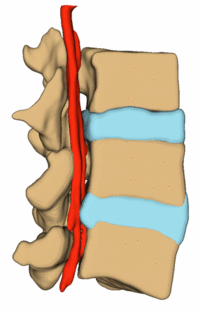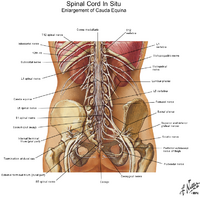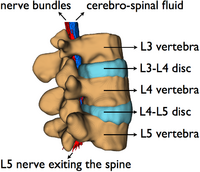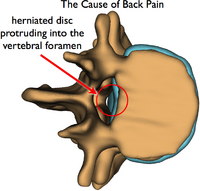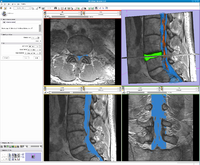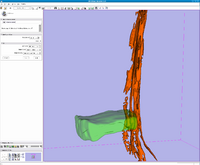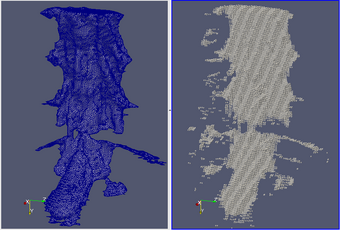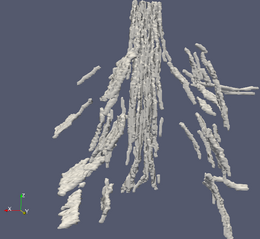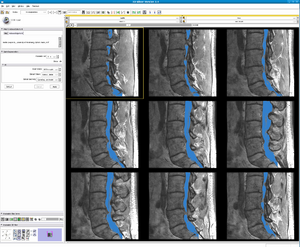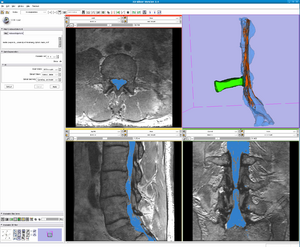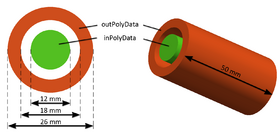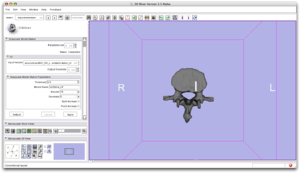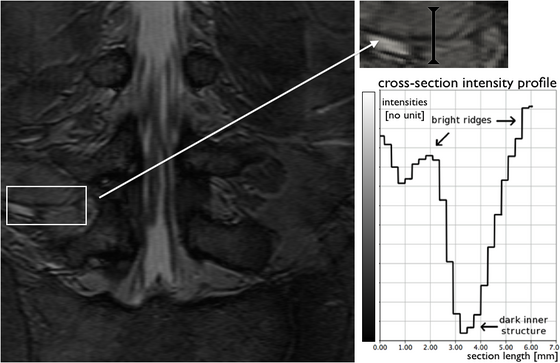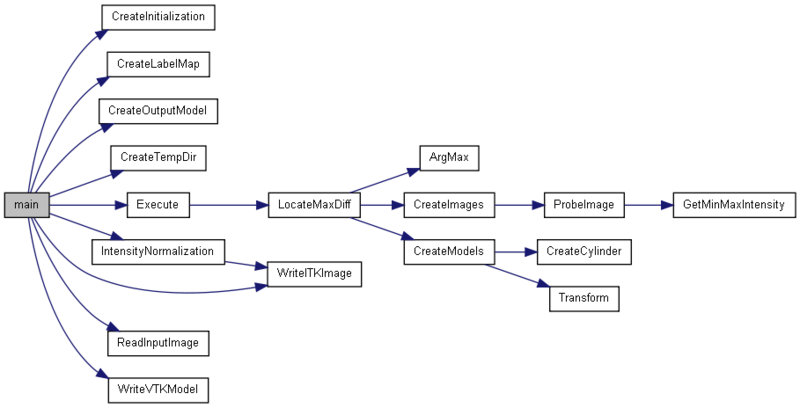Difference between revisions of "2010 Winter Project Week Spine Segmentation Module in Slicer3"
Sylvainjaume (talk | contribs) (Reorganize the screenshots. Remove duplicated screenshots.) |
m (Text replacement - "http://www.slicer.org/slicerWiki/index.php/" to "https://www.slicer.org/wiki/") |
||
| (24 intermediate revisions by 3 users not shown) | |||
| Line 1: | Line 1: | ||
__NOTOC__ | __NOTOC__ | ||
<gallery> | <gallery> | ||
| − | Image:Loepprich_Jaume_vertebra_Slicer_Jan2010.png| | + | Image:Martin_Loepprich_back_pain_animation_Feb_2010.gif|Rendering of segmentation results showing a disk herniation. This subject suffers from recurrent pain in the lower back. |
| − | Image: | + | Image:Loepprich_Jaume_vertebra_Slicer_Jan2010.png|MRI slice and 3D rendering showing spine segmentation results for surgical treatment of disk herniation. [http://www.youtube.com/watch?v=kkAuP80kE8E (video)] |
| − | Image: | + | Image:Martin_Loepprich_vertebrae_animation_Jan2010.gif|3D rendering of L3, L4 and L5 vertebrae (brown - top to bottom), inter-vertebral disks (blue) and bundles of spinal nerves (red). |
| + | Image:PW-SLC2010.png|3D Slicer's Spine Segmentation module was presented at the [[2010_Winter_Project_Week#Projects|NA-MIC Project Week]] in Salt Lake City, Jan 4-10, 2010. | ||
</gallery> | </gallery> | ||
| Line 10: | Line 11: | ||
* Martin Loepprich (University of Heidelberg) | * Martin Loepprich (University of Heidelberg) | ||
* Ron Kikinis, Steve Pieper (BWH) | * Ron Kikinis, Steve Pieper (BWH) | ||
| − | * Polina Golland (MIT) | + | * Polina Golland (MIT), Ehud Schmidt (BWH) |
<div style="margin: 20px;"> | <div style="margin: 20px;"> | ||
<div style="width: 27%; float: left; padding-right: 3%;"> | <div style="width: 27%; float: left; padding-right: 3%;"> | ||
| − | <h3> | + | <h3>Goal</h3> |
We are developing a Slicer module to segment the region within the thecal sac in MRI images of the spine. | We are developing a Slicer module to segment the region within the thecal sac in MRI images of the spine. | ||
Our objective is to provide a segmentation and visualization tool to improve the treatment of disc herniation. | Our objective is to provide a segmentation and visualization tool to improve the treatment of disc herniation. | ||
| − | The structures of interests are the cerebro-spinal fluid (CSF), the discs, the vertebrae and the spinal nerves | + | The structures of interests are the cerebro-spinal fluid (CSF), the discs, the vertebrae and the spinal nerves. |
</div> | </div> | ||
| Line 24: | Line 25: | ||
<div style="width: 27%; float: left; padding-right: 3%;"> | <div style="width: 27%; float: left; padding-right: 3%;"> | ||
| − | <h3>Approach | + | <h3>Approach</h3> |
Our plan for the project week is to integrate our code into Slicer 3.5. | Our plan for the project week is to integrate our code into Slicer 3.5. | ||
| Line 33: | Line 34: | ||
<div style="width: 40%; float: left;"> | <div style="width: 40%; float: left;"> | ||
| − | <h3> | + | <h3>Results</h3> |
The algorithm has been implemented in Slicer 3.5 as an extension module. | The algorithm has been implemented in Slicer 3.5 as an extension module. | ||
This volumetric pattern recognition algorithm is fully implemented as a Slicer module using ITK and VTK. | This volumetric pattern recognition algorithm is fully implemented as a Slicer module using ITK and VTK. | ||
| − | The module has been tested on data sets acquired at Brigham and Women's Hospital | + | The module has been tested on data sets acquired at Brigham and Women's Hospital. |
</div> | </div> | ||
</div> | </div> | ||
<div style="width: 97%; float: left;"> | <div style="width: 97%; float: left;"> | ||
| − | === | + | ===Method=== |
{| | {| | ||
| − | |[[Image: | + | |[[Image:Martin_Loepprich_back_pain_animation_Feb_2010.gif|thumb|200px|Segmentation of a 3D MRI dataset showing a disk herniation. This subject suffers from recurrent pain in the lower back.]] |
| − | |[[Image: | + | |[[Image:Netter_atlas_of_anatomy_4th_edition_spinal_cord.png|thumb|200px|Anatomy of the back showing the spinal cord and the lumbar nerves (Courtesy of Netter Atlas of Anatomy 4th Edition)]] |
| + | |[[Image:Sylvain_Jaume_vertebrae_and_discs_Jan2010.png|thumb|200px|The nerve bundles (red) are surrounded with cerebro-spinal fluid (CSF) as they traverse the L3 to L5 vertebral canal.]] | ||
|} | |} | ||
{| | {| | ||
| − | |[[Image:spine_segmentation_in_slicer_004.png|thumb| | + | | |
| − | |[[Image:Sylvain_Jaume_nerve_segmentation_rendering_2009.png|thumb| | + | The cause of back pain is the pressure of the herniated disc onto the spinal nerves. The herniated disc pushes the canal for the cerebro-spinal fluid (CSF). The resulting pressure on the nerve bundles can cause severe discomfort and even permanent disability if not treated. |
| + | The right image shows a disc that protrudes into the vertebral foramen and pinches the nerve bundles as they exit the spine. | ||
| + | | | ||
| + | {| | ||
| + | |[[Image:Sylvain_Jaume_disc_herniation_Jan2010.png|thumb|200px|Clinical application]] | ||
| + | |} | ||
| + | |} | ||
| + | |||
| + | {| | ||
| + | | | ||
| + | The CSF has a double role: it acts as a lubricant between the vertebrae and as a mechanical insulation to protect the nerves from outside shocks. The main challenge is to perform the segmentation in a fully automated way. | ||
| + | The image on the right shows the spine overlaid on the MRI image. | ||
| + | | | ||
| + | {| | ||
| + | |[[Image:spine_segmentation_module_in_slicer_001.png|thumb|200px|3D Slicer software]] | ||
| + | |} | ||
| + | |} | ||
| + | {| | ||
| + | | | ||
| + | This patient-specific illustration can help the surgeon during a minimally invasive intervention on the herniated disc. | ||
| + | The image on the right shows an herniated disc that protrudes into the vertebral foramen and reduces the opening for the nerve bundles and the cerebro-spinal fluid (CSF). | ||
| + | | | ||
| + | {| | ||
| + | |[[Image:spine_segmentation_module_in_slicer_002.png|thumb|200px|Disc herniation]] | ||
| + | |} | ||
| + | |} | ||
| + | {| | ||
| + | |[[Image:spine_segmentation_in_slicer_004.png|thumb|340px|Surface meshes and volumetric meshes of our automatically created model of the CSF. The paths where the nerves exit the spine appear as two roots descending on each side of the spinal column.]] | ||
| + | |[[Image:Sylvain_Jaume_nerve_segmentation_rendering_2009.png|thumb|260px|Results of our automated nerve segmentation algorithm. The 3D rendering shows the nerves exiting the spinal cord and the ganglia.]] | ||
|} | |} | ||
| Line 71: | Line 101: | ||
|} | |} | ||
| + | <div style="width: 97%; float: left;"> | ||
| − | + | ===Video=== | |
| − | + | The following video shows the segmentation of a herniated disc from MRI using 3D Slicer | |
| − | + | ||
| + | [[Media:Herniated_disc_segmentation_using_3DSlicer.ogg]] | ||
==References== | ==References== | ||
| − | * | + | *Expectation-Maximization segmentation: [http://www.na-mic.org/Wiki/index.php/EMSegment EMSegment] module in Slicer |
| − | + | *Creation of a statistical atlas: [https://www.slicer.org/wiki/Modules:AtlasCreator-Documentation-3.5 AtlasCreator] module in Slicer | |
| + | *MRI bias field correction: [https://www.slicer.org/wiki/Modules:MRIBiasFieldCorrection-Documentation-3.5 MRIBiasFieldCorrection] module in Slicer | ||
| + | *More references: [http://people.csail.mit.edu/sylvain Sylvain Jaume] at MIT CSAIL | ||
</div> | </div> | ||
Latest revision as of 18:07, 10 July 2017
Home < 2010 Winter Project Week Spine Segmentation Module in Slicer3MRI slice and 3D rendering showing spine segmentation results for surgical treatment of disk herniation. (video)
3D Slicer's Spine Segmentation module was presented at the NA-MIC Project Week in Salt Lake City, Jan 4-10, 2010.
Key Investigators
- Sylvain Jaume (MIT)
- Martin Loepprich (University of Heidelberg)
- Ron Kikinis, Steve Pieper (BWH)
- Polina Golland (MIT), Ehud Schmidt (BWH)
Goal
We are developing a Slicer module to segment the region within the thecal sac in MRI images of the spine. Our objective is to provide a segmentation and visualization tool to improve the treatment of disc herniation. The structures of interests are the cerebro-spinal fluid (CSF), the discs, the vertebrae and the spinal nerves.
Approach
Our plan for the project week is to integrate our code into Slicer 3.5. Our code analyzes the intensity profile of different regions in the MRI and automatically defines the optimum region for the CSF.
Results
The algorithm has been implemented in Slicer 3.5 as an extension module. This volumetric pattern recognition algorithm is fully implemented as a Slicer module using ITK and VTK. The module has been tested on data sets acquired at Brigham and Women's Hospital.
Method
|
The cause of back pain is the pressure of the herniated disc onto the spinal nerves. The herniated disc pushes the canal for the cerebro-spinal fluid (CSF). The resulting pressure on the nerve bundles can cause severe discomfort and even permanent disability if not treated. The right image shows a disc that protrudes into the vertebral foramen and pinches the nerve bundles as they exit the spine. |
|
|
The CSF has a double role: it acts as a lubricant between the vertebrae and as a mechanical insulation to protect the nerves from outside shocks. The main challenge is to perform the segmentation in a fully automated way. The image on the right shows the spine overlaid on the MRI image. |
|
|
This patient-specific illustration can help the surgeon during a minimally invasive intervention on the herniated disc. The image on the right shows an herniated disc that protrudes into the vertebral foramen and reduces the opening for the nerve bundles and the cerebro-spinal fluid (CSF). |
|
Video
The following video shows the segmentation of a herniated disc from MRI using 3D Slicer
Media:Herniated_disc_segmentation_using_3DSlicer.ogg
References
- Expectation-Maximization segmentation: EMSegment module in Slicer
- Creation of a statistical atlas: AtlasCreator module in Slicer
- MRI bias field correction: MRIBiasFieldCorrection module in Slicer
- More references: Sylvain Jaume at MIT CSAIL




